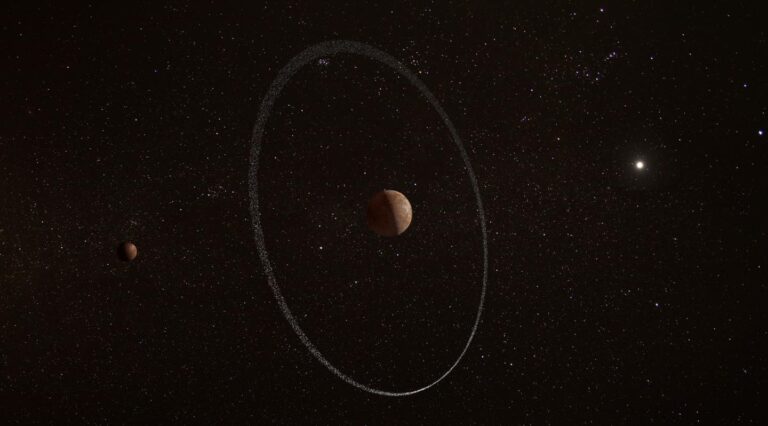Quaoar, a remote dwarf planet, possesses an unexpected ring despite the odds.
A ring has been placed around a small celestial body that orbits beyond Neptune.
Scientists have made a remarkable discovery of a ring system surrounding a small celestial object located beyond Neptune’s orbit. However, this observation has presented a perplexing enigma: How is it possible for this ring system to exist when, according to all available information, it shouldn’t?

The ring in question encircles Quaoar, a diminutive dwarf planet situated over 4 billion miles away from the sun, which is approximately 44 times the distance between Earth and our own star. Detecting a dense ring encompassing such a small and distant entity was an arduous task in itself. Yet, what truly astonished the international team of researchers who made this breakthrough was the fact that the ring appears to orbit Quaoar at an unexpectedly distant location. At this distance, the gravitational force exerted by the dwarf planet should be too feeble to prevent the individual particles within the ring from coalescing into one or more moons.
Bruno Morgado, an astronomer at the Federal University of Rio de Janeiro and the lead author of a recently published paper in the journal Nature, explains, “This ring is not situated where we would anticipate it to be. This discovery may potentially alter our understanding of the formation of rings.”
In a commentary published in the same edition of Nature, Matthew Hedman, a physicist from the University of Idaho, describes Quaoar’s ring system as being “in conflict with our current comprehension of how such rings are sustained.”
Rings consist of fragments of dust, ice, and other substances, revolving in a disk around a celestial body. Initially, astronomers were only aware of the magnificent rings of Saturn, which were first observed and studied in the 1600s. It was not until Voyager 1 flew past Jupiter in 1979 that scientists discovered that the largest planet in our solar system also possessed a ring system, although it was not as remarkable as Saturn’s. It is now understood that all of the gas giants in our solar system have ring systems. Additionally, rings have been identified around a few distant objects, such as Humea, which, like Quaoar, Eris, and Pluto, are classified as trans-Neptunian objects.
All of these ring systems, except for Quaoar’s, share a common characteristic—their rings orbit within the Roche limit of their respective celestial bodies. The Roche limit is the distance at which the gravitational force of the celestial body can no longer prevent the ring material from clumping together and forming larger objects, eventually leading to the formation of a moon. Within this limit, the varying strength of gravity at different altitudes keeps the ring particles dispersed.
However, Quaoar’s Roche limit is approximately 1,100 miles from its center, while the dense ring orbits at a distance of 2,500 miles from the center of this dwarf planet. According to Hedman, the gravitational attraction between chunks of water ice in the ring should easily overcome the variations in Quaoar’s gravitational pull. Therefore, there must be another explanation as to why this material has not merged to form a moon.
Morgado and his colleagues propose several explanations. One possibility is that the ring material is relatively new, resulting from a collision with a moon orbiting Quaoar, and has not had sufficient time to reassemble. However, their computer models suggest that this material would condense into a new moon within a few decades, making this explanation unlikely.
It is also conceivable that the composition of the ring material itself possesses a greater degree of elasticity than what models have predicted. In this case, each fragment would be more inclined to rebound off one another rather than adhere together, even without the gravitational pull of Quaoar to keep them apart.
Another potential explanation is that the ring system experiences regular disturbances caused by the gravitational influence of another celestial body, such as Quaoar’s moon, Weywot, or perhaps an undiscovered moon. Studying trans-Neptunian objects is undeniably challenging, and the discovery of this ring was only made possible due to the research group’s utilization of a diverse range of state-of-the-art telescopes focused on Quaoar. This includes the European Space Agency’s ESA’s CHaracterising ExOPlanet Satellite (Cheops) mission, a space telescope that detected Quaoar’s ring by monitoring changes in the brightness of background starlight.
“Now, it is imperative that we continue observing Quaoar to gain a better understanding of this ring and to observe any potential changes over time,” Morgado emphasizes. “Furthermore, additional dynamical studies and simulations must be conducted to determine the conditions under which a ring remains stable at such a significant distance from the Roche limit.”
The outcomes of further investigation could potentially compel astronomers to revise their comprehension of the Roche limit. It is also plausible that Quaoar represents an exception to the established rule, but one that offers valuable insights into the orbital dynamics of other substantial structures, including exoplanets and galaxies, as Morgado suggests.
Do not forget to share your opinion with us to provide you with the best posts !




0 Comments